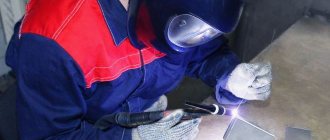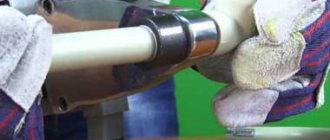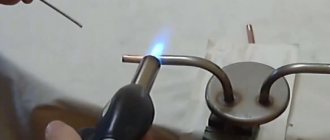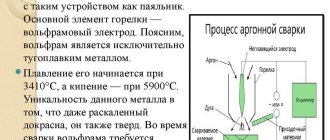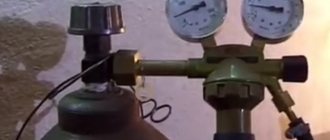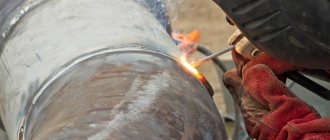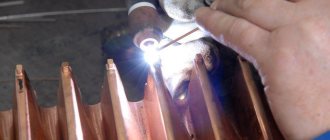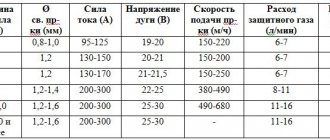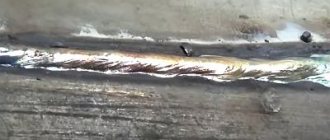To reliably fix two or more aluminum-based elements to each other, it is best to use argon welding. To perform welding work in any inert gas environment, you will need special equipment and accessories.
And for beginners in this area, it is very important to study in detail how to cook aluminum with argon, since the special apparatus for connecting such parts is quite complex in its structure.
If you connect them using a semi-automatic device, you need to have a special welding wire and an argon cylinder. The welder must know the basics of working with metals and be qualified. If you are just learning, it is better to watch the training video and study the instructions.
Required technical information
Often the need for argon-arc welding arises not only in enterprises, but also at home. For example, you will need to repair a car or an electric boiler, where the tank is made of stainless steel, although there are many other units in the manufacture of which alloys and non-ferrous metals are involved. Therefore, knowing the technology of the process, you can learn to cook on your own.
What it is
This technology provides a seemingly strange hybrid combination of gas and electricity. However, the argon welding method works and allows you to work with almost all metals. This method is most in demand for welding stainless steel, cast iron, copper and aluminum - they are most often used to create various components and mechanisms. In everyday life, almost every person comes across products where the argon-arc method was used - these are small bronze hooks for hangers, various chandeliers, sconces and floor lamps, or the back of our refrigerator.
As you can see, argon-arc welding, or, more precisely, products that could not be made without its use, surrounds us in everyday life, therefore, this method can be very useful to any home craftsman. But, as you know, the birth of a good practitioner must always be confirmed by theoretical knowledge, and it cannot be otherwise. Here, of course, there is no need to study the composition of elements according to the periodic table, but there is no way to do without knowledge and understanding of the physical processes of melting metals in an inert environment.
The technology involves a hybrid combination of gas and electricity Source svarkalegko.com
Argon welding technology contains a solution to the dilemma: oxygen is needed to maintain combustion, but O2 promotes the oxidation of metals, which adversely affects the joint. When the weld pool hardens, many bubbles form there, which does not contribute to the strength of the seam, and if it is aluminum, then it simply burns out. Inert argon supplied to the bath envelops the welding site in a protective cloud, which minimizes the oxidation process. As you can see, an inert gas is an insulator from other elements that are found in ordinary air under natural conditions, that is, from the air we breathe. Ar is heavier than all the constituent gases of this composition, so the welding arc and part of the pool end up in its shell.
Note: in some cases, helium (He) is used instead of argon (Ar), which is also an inert gas. But this happens more as an exception than as a rule, since helium is much more expensive.
Please note why argon is preferred:
- Ar is heavier than all atmospheric gases, therefore, it is capable of displacing them from the bath;
- inert Ar does not react with substances that are present during the welding regime.
Note: in some cases, helium (He) is used instead of argon (Ar), which is also an inert gas. But this happens more as an exception than as a rule, since helium is much more expensive.
Now let's talk about the methods by which such a process is currently carried out. There are only three ways:
- Manual. When a welder works with manual argon arc welding, he needs to use both hands - one of them will have to hold the torch and the other the rod.
- Semi-automatic The welder holds and directs the torch by hand, and the rod is fed automatically.
- Machine. The movement of the torch and rod is automatic, but under the supervision of the operator. There are also lines where human functions are performed by a numerically controlled robot.
T-beam assembly-welding line Source google.com.ua
Preliminary edge preparation
The versatility of using manual argon arc welding also has a downside. This is the most capricious and finicky welding in terms of preparing the surfaces to be welded, edges, parts, assemblies, and so on. A professional argon worker will definitely have a whole arsenal of equipment, tools, accessories and all kinds of devices for preparatory work.
This includes an abrasive tool, and a huge number of burrs, cutters, nozzles, as well as everything that provides a chemical cleaning method: from a bottle of acetone and a rag - when working in a personal garage, to huge electrochemical galvanic baths used in large-scale production: machine tools - and shipbuilding, in the manufacture of containers for the chemical, food and cryogenic industries.
50% of success in argon arc welding is the cleanliness of the elements being welded, no matter how trite it may sound, so it is recommended to start work by cleaning the parts of the surfaces being welded from fats, oxides and other contaminants.
More on this topic on our website:
- New electrode welding lessons - what is “boat welding” Welding with a metal electrode is the oldest and most famous technology for arc welding. Electrode welding lessons are in demand among both professionals and amateurs.
Welding stainless steel with an electrode - the process of welding stainless steel According to the accepted classification, stainless steel belongs to high-alloy steels that have high corrosion resistance. The main alloying component in its composition is chromium, the content of which varies.
Argon welding - video on how to properly perform argon welding Before starting work, you should carefully review “Argon welding. Video" in order to understand the advantages of its use, the nuances of the process itself, as well as the most common mistakes that...
Argon welding - prices per cm from a good argon welder Argon welding is popular because, compared to other types of welding, it is distinguished by the neatness of the seam, its strength and durability. Argon welding can be done independently or invited.
Read also: Household battery-powered vacuum cleaner
News
Many argue that high-quality amateur photography from a phone is impossible, or at least difficult under non-ideal conditions. Probably many professional photographers would be okay with this
Where to order an elevator
There is a widespread, catastrophic problem with elevator equipment in Russia. Every year, tens of thousands of lifts that have expired their warranty period fail. It’s good if the equipment has had time to work
Spare parts for septic tanks
Under such conditions, the best option would be an anaerobic septic tank with soil treatment, since it is simple, energy-independent and rarely maintained. When filtering through soil, wastewater first
Making stamps
Taxi. The first thing that comes to mind with this word is a car, yellow with black checkers, which will take you wherever you want. This word evokes such associations among passengers. How many
Unedged board
Unedged board is a board whose edges are not sawn or partially sawn. It is most often used for the manufacture of various floorings, sheathing, roof sheathing, and elements of load-bearing structures.
Furniture handles online store
Which is cheaper? How not to confuse metabox and tandembox: let's understand the names. Blum and Hettich are the most popular manufacturers of furniture fittings. Often the buyer chooses between them and does not know
Agent's office
How to make the right choice in work, business and life that you will never regret. We want to tell you about an amazing and very simple technique: 7 questions that will allow you to assess the situation
Flags
The national flag is a symbol of the sovereignty of a state entity. Its presence is necessary in all events on a national scale. This flag is often displayed on government buildings.
Wooden table calendar
Today it is difficult to live without up-to-date information, without being oriented in what is happening and without reference to the chronology of events. At the same time, all sensible people know perfectly well that without using a calendar,
Rotational vibrating sieve
Sieves for sifting molding materials must ensure the destruction of lumps and the separation from the total mass of the mixture of pieces of rods, scrap and other random objects that fall into it during knocking out
Welding work
Argon arc welding allows you to ensure high quality and strength of the connection Source triton-welding.ru
Like any work, the welding process begins with the preparation of tools and materials. The place where the seam will be located in the future must be cleaned of dirt and corrosion - a metal brush is usually used for this, and the quality of the weld will depend on the cleanliness of the edges (the absence of undesirable elements there). The filler rod is selected according to the thickness of the metal being welded. The workpiece is connected to the workpiece (crocodile grip), and the torch is connected to the TIG and through the hose to the cylinder.
Welding machine MIGOMAT 3in1 MIG 200 MMA TIG 200A MIG / MAG Source vroda.co.ua
There are several welding technologies, but they are mainly needed for industrial enterprises in the manufacture of parts with high precision parameters. Therefore, let’s pay attention to only two of them:
- TIG is a manual tungsten arc welding process where the filler is applied manually.
- MIG/MAG – automated consumable electrode welding (autofeed).
For such technologies, you can use units that support one thing, or you can use universal devices, for example, such as in the top photo. In any case, it will be very convenient for home use, as well as for a beginner (future) welding specialist.
Bar selection
BACX - chrome-plated stainless steel rods X20Cr13 (W1.4021), X46Cr13 (W.14034) Source smsurfo.ru
To fill the weld pool with homogeneous metal, special filler rods are used. Considering the fact that you have to work with different metals, the composition will be different. They can be classified according to homogeneous materials:
- stainless steel;
- aluminum and alloys;
- copper and alloys;
- nickel for cast iron.
What are the challenges of welding stainless steel?
The difficulty of welding stainless steel is explained by the properties of this metal, which alloying additives give it. Compared to low-carbon steel, stainless steel has lower thermal conductivity (two times lower), which is a negative factor for welding work. Due to the low thermal conductivity of the metal, high temperature will be concentrated at the place where the connection is made and not actively removed from it. This can cause the joint area to overheat and even burn through the metal. That is why the stainless steel welding technology provides for a reduction in the welding current: its value is selected 20% lower than when welding conventional steels.
Display of semi-automatic welding machine with digital indication of operating current and voltage
Another characteristic of stainless steel that must be taken into account when welding is an increased coefficient of linear expansion and, as a consequence, significant linear shrinkage. It is this property of stainless steel that causes parts made from it to undergo significant deformations when performing welding work, often leading to the appearance of cracks on their surface. Taking this into account, a larger gap should be left between the workpieces being connected, which will compensate for deformation processes.
Stainless steel has increased electrical resistance, which has a very negative effect on welding if it is performed with a high-alloy steel electrode. Such an electrode, which also has high electrical resistance, begins to heat up greatly. This leads to deterioration in the quality of the formed weld. If you are going to cook stainless steel with such electrodes, you should use products of a minimum length.
A weld crack is the most dangerous defect leading to structural failure
If the correct thermal conditions are not observed when welding stainless steel, this alloy may lose its anti-corrosion properties.
This is explained as follows. With significant heating (over 500 degrees), chromium and iron carbide begin to form at the boundaries of crystalline grains of the metal. This is how pockets of corrosion appear and further spread. To avoid this negative phenomenon, which is called intergranular corrosion, it is necessary to very quickly cool stainless steel parts immediately after completing welding work. However, this method is effective only if you are welding stainless steel of the chromium-nickel group.
Some features
As with any process and technology, argon-arc welding has some features. That is, here we want to draw attention to working with a non-consumable tungsten electrode. Once upon a time, people who mastered this method had to graduate from a vocational school or at least take special courses for which they received a referral from the enterprise at the place of employment. But, as everyone knows, progress and technology do not sleep - they are simplified, automated and in our time have become accessible to almost any adult who wants to master this profession. We can say that now the TIG 200A MIG/MAG can be found in almost every tenth garage.
Welding with a non-consumable tungsten electrode in an inert atmosphere of argon Source fgpip.ru
At first glance, this method is no different from conventional arc welding in an inert environment, but this is not so. There are the following nuances:
- the tungsten electrode should not touch the surface of the workpiece (as in conventional electric welding) - here an oscillator is used to create an arc;
- the gap between the workpiece and the electrode should not change (the reflex develops over time) so that the capacity of the weld pool is not disturbed, on which the quality of the seam depends.
Note: unlike electric welding, pendulum oscillations of the electrode are not needed here - it must move strictly along the seam in front of the burner.
Modes
Let's consider four modes:
- This method is based on protecting the weld pool from oxygen, which oxidizes metals and sometimes even promotes their burning (for example, aluminum). This mode obliges the welder to monitor the argon insulation, or more precisely, the direction of the arc. It is prohibited to start the process without turning on argon, since without such protection the seam will simply be damaged. To finish the seam without causing oxides, you need to hold the switched-off burner over the melt for another 5-15 seconds while the gas is still flowing.
- To ensure a uniform seam, the wire feed speed should not change - each jerk will look like a bump or hole. With automatic feeding, such problems do not arise. In the manual method, everything depends on the skill of the welder - he moves the torch and solder along the seam at the same speed (the rod must be in front of the torch).
- The consumption of inert gas will be constant, in accordance with GOST 10157-2016 (corrected from 10157-79).
- Current setting. It is almost impossible to set this parameter correctly without experience. Therefore, a novice welder needs to refer to the table below and this is without options.
| Workpiece thickness, mm | Electrode Ø, mm | Ø wire, mm | Current, A | Ar flow rate for protection dm3/min | |
| arcs | reverse side of the seam | ||||
| 0,5-1 | 1,5-2,0 | 1,0-1,5 | 25-60 | 8-10 | 2-3 |
| 2 | 2,0-2,5 | 1,5-2,0 | 80-100 | 8-10 | 2-4 |
| 4 | 2,5-3,0 | 2,0-2,5 | 120-100 | 12-16 | 2-4 |
| 8 | 2,5-3,0 | 2,5-3,0 | 160-180 | 12-16 | 2-4 |
| 12 | 3,0-4,5 | 3,0-4,0 | 180-220 | 12-16 | 2-4 |
Important! To create a high-quality seam, equipment settings may vary depending on the metal.
